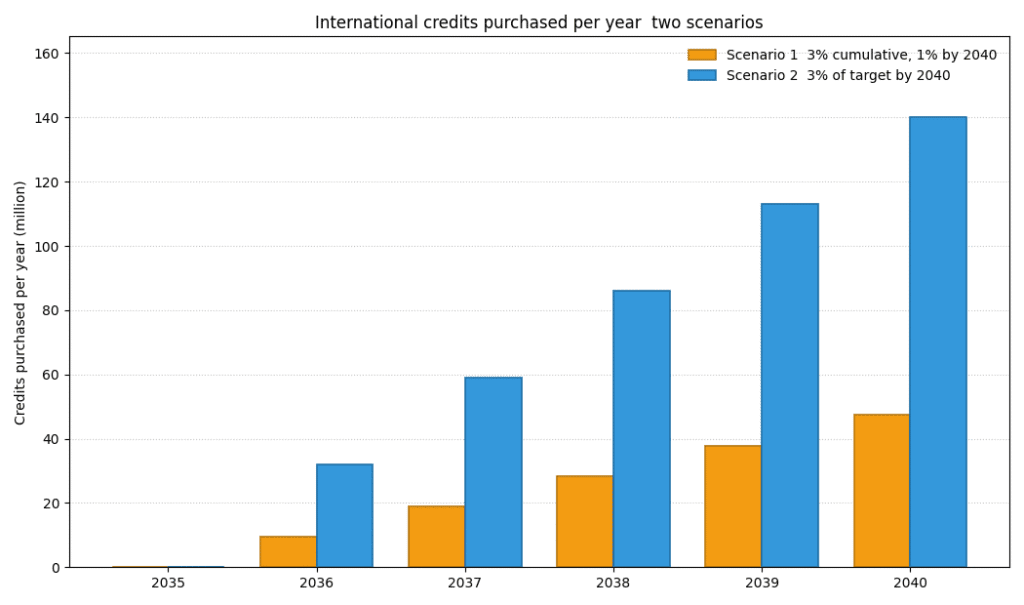The use of international carbon credits in the EU’s 2040 climate target could result in the outsourcing of 140 million tonnes to a whopping 430 million tonnes of emissions. It should be zero tonnes.
The European Commission’s proposal to use a limited amount of international carbon credits towards the EU’s 2040 climate target contains a critical ambiguity that could dramatically alter both the environmental outcome, economic impact and costs of this problematic loophole. The proposal specifies that international credits would constitute up to “3% of 1990 EU net emissions”. However, such unclear language opens up varied interpretations of how much 3% actually is.
According to our sources, the European Commission gave a presentation to EU government representatives in which the EU executive outlined two possible interpretations for the 3%.
Understanding the scenarios
The first interpretation (Scenario 1) assumes that the 3% allowance refers to the total cumulative amount of credits to be used over the five-year period from 2036 to 2040. Under this scenario, the EU would use approximately 140 million credits in total, spread over five years. When assuming a linear increase in credit usage over time, and spreading 140 million credits over the course of five years, the EU would buy around 47 million credits in 2040, corresponding to 1% of the EU’s 1990 emissions.
The second interpretation (Scenario 2) sees the 3% as the amount to achieve through a “build up”. In this case, we would see the EU in 2040 buying around 140 million credits, corresponding to 3% of EU 1990 emissions, but buying 290 million credits before 2040 during the build up. This leads to a whopping 430 million credits over the entire period.
Seeing a linear increase of purchased credits in both scenarios makes sense, because generating bespoke credits rather than buying what is offered on the market today requires significant time and effort. This includes establishing cooperative approaches (which is Article 6 jargon for trade agreements) with seller countries, setting up methodologies and carbon crediting projects, as well as the accompanying monitoring, reporting and validation.
Moreover, these steps will all have to be executed and projects will have to deliver actual climate outcomes before any credits can be issued. In addition, in order to prevent negative social and environmental impact from these projects, a great amount of due diligence is required prior as well as during and after these projects take place, such as by obtaining free, prior, and informed consent from indigenous peoples and local communities, establishing local stakeholder consultations, and conducting environmental impact assessments.

Environmental fallout
Both interpretations result in higher emissions in the EU than would have occurred had the 2040 target remained entirely domestic. Under the cumulative scenario, EU emissions in 2040 would be 10% higher than they would be with a fully domestic approach to reaching the target. Under Scenario 2, emissions would be 30% higher than under a fully domestic target. Both scenarios represent a fundamental shift away from what the Commission had originally promised – and assessed in the impact assessment – as the 2040 target (like all EU targets) was always supposed to be domestic, as postulated in the EU Climate Law.
Discussions on the 2040 target have restarted following the summer recess. Unfortunately, some countries are reportedly pushing for even higher percentages of international credit use, potentially up to 10% of 1990 emissions. Such levels would correspond to EU emissions that are at least 40% higher compared to domestic action, and could potentially result in greenhouse gas emissions in 2040 being double what a net 90% domestic target would generate.
| Scenario | Interpretation | Total # credits used | Credits purchased in 2040 (counted towards the 2040 target) | 2040 emissions with credits compared to a fully domestic target | Total cost in 2036-2040 (€50 per credit) | Total cost in 2036-2040 (€60 per credit) | Total cost in 2036-2040 (€70 per credit) |
| Scenario 1: Cumulative 3% across the period | 3% used cumulatively in 2036-2040 | 140 million credits | 1% of 1990 emissions | 10% higher | €7 billion | €8.4 billion | €9.8 billion |
| Scenario 2: build up to 3% in 2040 | 3% (counted toward the 2040 target) | 430 million credits (corresponding to 9% of the EU’s 1990 emissions) | 3% of 1990 emissions | 30% higher | €21.5 billion | €25.8 billion | €30.1 billion |
High price tag
Both interpretations impose significant financial burdens on the EU budget. Assuming a price per credit of €50, 60, or 70, Scenario 1 requires the EU to spend between €7 and almost €10 billion over the 2036-2040 period, while Scenario 2 would translate to total costs between €21.5 and over €30 billion over the same period. Regardless of which interpretation is chosen, these numbers represent a substantial financial burden, and these resources are diverted away from domestic decarbonisation efforts and climate finance for developing countries.
The price range considered for these estimates is quite conservative. Current evidence from international carbon markets suggests that prices for high-quality credits could turn out to be higher than our estimates. Switzerland is engaging under Article 6, with credit prices around €30 by the end of 2024 and €34 for credits currently in the pipeline. Controversies related to Swiss deals seem to indicate that such a price range is not high enough to guarantee the integrity of the credits. Switzerland’s agreement with Thailand has faced criticism over the lack of additional climate benefits it brings and low credit quality, and a Swiss deal with Ghana has been criticised for lack of transparency and controversy over projects that were marketed as sustainable development but appeared designed primarily for investor profit. Given these quality concerns and taking into account a decade of inflation, we might see prices even higher than those we considered if the EU is to buy good quality credits.
The unfairness of international credits
Introducing international credits undermines the 2040 target and will delay essential emissions reductions, potentially helping to escalate the climate crisis beyond critical tipping points. Relying on international credits instead of investing in domestic decarbonisation only postpones the inevitable transition and makes the domestic climate neutrality goal the EU has for 2050 harder to achieve, imposing an unfair burden on future generations of Europeans. In fact, achieving a 2040 emission reduction of 90-95% domestically remains both feasible and would keep the EU on a credible path to climate neutrality by 2050, according to two European Scientific Advisory Board on Climate Change (ESABCC) assessments (1 and 2).
Moreover, despite the fact that in these scenarios the EU would be spending significant amounts on Article 6 credits which are expected to come mostly from countries in the Global South, that does not mean the EU would be providing climate finance – quite the contrary, as the EU would be paying for services rendered rather than repaying its climate debt to these countries. In addition, the Article 6 framework is set up in a way that risks exacerbating existing inequalities. Purchasing credits for use toward EU targets is not guaranteed to benefit the seller country and may actually make it harder for those countries to reach their own climate goals, given they have to subtract sold credits from their GHG accounting to ensure they are only counted by the buyer country.
Considering the lack of clarity and details publicly communicated by the Commission, it is even more concerning that the EU executive is proposing to take on all these risks without even having carried out an impact assessment first on the implications of introducing such flexibility. In fact, this flexibility contradicts the findings of an earlier Commission impact assessment on the 2040 target, which found the range of domestic 90-95% net emission reduction by 2040 as the preferred option with the highest net benefits from avoided climate damages and air pollution.
Optimising the 2040 target
The proposal by the Commission is severely lacking. The European Parliament and the Council have the responsibility to bring this policy file back in line with science, and limit the devastating impact the climate crisis is already inflicting on Europe and the rest of the world.
Setting a net 90% reduction target by 2040 is the bare minimum, and sits at the lower end of the target range recommended by the ESABCC. Any reliance on Article 6 credits to achieve the net 90% target should be discarded and the policy architecture and package to be proposed next year should thus also aim at net 90% (83% gross) domestic emission reductions. If engagement under Article 6 is to be considered in any way, it should be only to increase this ambition by providing climate contributions to support climate mitigation outside the Union, done on top of the net 90% domestic reduction and of its climate finance responsibility.
But the EU has the capacity and potential to achieve so much more. It is entirely feasible, as the ESABCC and others have demonstrated, for the Union to reach climate neutrality by 2040, and net-negativity thereafter, to increase the fairness of its global climate action. The only thing that is lacking is the political will to do so.
Author
-

Federica Dossi is a global carbon markets expert whose main focus is Article 6 of the Paris Agreement.
View all posts






